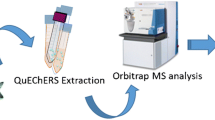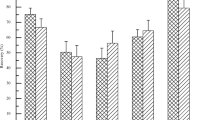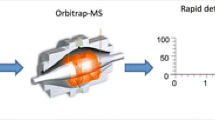Abstract
Triazine herbicides are used extensively in agriculture and aquaculture worldwide because of their broad effectiveness in weed control. However, after they are discharged into the sea, they seriously contaminate aquatic ecosystems and threaten aquatic organisms, especially shellfish. Currently, there are no established methods for the detection and confirmation of triazine herbicides and their metabolites in biological matrixes. Hence, the food safety of aquatic products cannot be accurately evaluated, which creates a technical barrier against international aquatic product trade. In this study, for the first time, a method was developed for the analysis and confirmation of seven triazine herbicides and 13 metabolites in shellfish, based on alkaline acetonitrile extraction and neutral Al2O3 cartridge purification coupled with internal standard calibration. Specifically, quantitative and qualitative analysis was conducted using high-performance liquid chromatography-triple quadrupole mass spectrometry (HPLC-MS/MS), and accurate identification was carried out by quadrupole orbitrap high-resolution mass spectrometry (Q/E Orbitrap HRMS). The results showed that target analytes demonstrated good linearity within the corresponding range (R2 > 0.995). The limit of detection and limit of quantitation of the proposed method were 0.1 and 0.3 μg/kg, respectively. The average recoveries of analytes were between 70.0% and 120% when spiked at three levels with blank oyster (Crassostrea gigas) as the matrix, and the relative standard deviations (RSDs) were all less than 12% (n=6). The proposed method was successfully applied for the detection of triazine herbicide residues in oyster samples during actual breeding, and the presence of DIP, HP, DEHA, and other metabolites in positive samples was confirmed by Q/E Orbitrap HRMS. This method exhibits high accuracy, high sensitivity, and good reproducibility. It has promising application prospects in the field of hazard analysis and the positive identification of aquatic products.
Graphical abstract






Similar content being viewed by others
Data availability
The data that support the findings of this study are available on request from the corresponding author on reasonable request.
Code availability
Not applicable.
References
Diez MC. Biological aspects involved in the degradation of organic pollutants. J Soil Sci Plant Nut. 2010;10(1):244–67.
Gfrerer M, Martens D, Gawlik BM. Triazines in the aquatic systems of the Eastern Chinese Rivers Liao-He and Yangtse. Chemosphere. 2002;47(4):455–66.
Yazgan MS, Tanik A. A new approach for calculating the relative risk level of pesticides. Environ Int. 2005;31(5):687–92.
Rebich RA, Coupe RH, Thurman EM. Herbicide concentrations in the Mississippi River Basin-the importance of chloroacetanilide herbicide degradates. Sci Total Environ. 2004;321(1-3):189–99.
Globe Newswire, Global Herbicide Market 2016-2022. http://inpublic.globenewswire.com/. 2017.
Herrero-Hernández E, Rodríguez-Cruz MS, Pose-Juan E, Sánchez-González S, Andrades MS, Sánchez-Martín MJ. Seasonal distribution of herbicide and insecticide residues in the water resources of the vineyard region of La Rioja (Spain). Sci Total Environ. 2017;609:161–71.
GBF S, Bracht L, Parizotto AV, Comar JF, Peralta RM, Bracht F, et al. Kinetics of the metabolic effects, distribution spaces and lipid-bilayer affinities of the organo-chlorinated herbicides 2, 4-D and picloram in the liver. Toxicol Lett. 2019;313:137–49.
Yang L, Li H, Zhang Y, Jiao N. Environmental risk assessment of triazine herbicides in the Bohai Sea and the Yellow Sea and their toxicity to phytoplankton at environmental concentrations. Environ. Int. 2019;133(Part A):105175.
Munaron D, Tapie N, Budzinski H, Andral B, Ggonzalez JL. Pharmaceuticals, alkylphenols and pesticides in Mediterranean coastal waters: Results from a pilot survey using passive samplers. Estuar coast shelf S. 2012;114:82–92.
Mai C, Theobald N, Lammel G, Hühnerfuss H. Spatial, seasonal and vertical distributions of currently-used pesticides in the marine boundary layer of the North Sea. Atmos Environ. 2013;75:92–102.
Rossi SC, Silva MD, LDS P, CAO R, Cestari MM. Assis HCS. Sublethal effects of waterborne herbicides in tropical freshwater fish. B Environ Contam Tox. 2011;87(6):603–7.
Hayes TB, Collins A, Lee M, Mendoza M, Noriega N. Hermaphroditic, demasculinized frogs after exposure to the herbicide atrazine at low ecologically relevant doses. P Natl Acad Sci USA. 2002;99(8):5476–80.
Kim JY, Mulchandani A, Chen W. An immunoassay for atrazine using tunable immunosorbent. Anal Bioanal Chem. 2003;322(2):251–6.
Bishop PL, Willett CE. The use and acceptance of other scientifically relevant information (OSRI) in the U.S. Environmental Protection Agency (EPA) endocrine disruptor screening program. Birth Defects Res B. 2014;101(1):3–22.
Kibria G, Hossain MM, Mallick D, Lau TC, Wu R. Monitoring of metal pollution in waterways across Bangladesh and ecological and public health implications of pollution. Chemosphere. 2016;165:1–9.
Scheunert I, Reuter S. Formation and release of residues of the 14C-labelled herbicide isoproturon and its metabolites bound in model polymers and in soil. Environ Pollut. 2000;108(1):61–8.
Jacomini AE, WEP A, Martinêz AS, Bonato PS. Bioaccumulation of atrazine in freshwater bivalves anodontites trapesialis (Lamarck, 1819) and corbicula fluminea (MÜller, 1774). Arch Environ Con Tox. 2006;51(3):387–91.
Bichon E, Dupuis M, Bizec BL, André F. LC–ESI-MS/MS determination of phenylurea and triazine herbicides and their dealkylated degradation products in oysters. J Chromatogr B. 2006;838(2):96–106.
Peng J, Gan JH, Ju XQ, Liu T, Chen JW, He L. Analysis of triazine herbicides in fish and seafood using a modified QuEChERS method followed by UHPLC-MS/MS. J Chromatogr B. 2021;1171:122622.
Saglio P, Rijasse T. Behavioral responses to atrazine and diuron in goldfish. Arch Environ Con Tox. 1998;35(3):484–91.
Turiel E, Díaz-Alvarez M, Martín-Esteban A. Supported liquid membrane- protected molecularly imprinted beads for the solid phase micro-extraction of triazines from environmental waters. J Chromatogr A. 2016;1432:1–6.
Ji F, Zhao L, Yan W, Feng Q, Lin J. Determination of triazine herbicides in fruits and vegetables using dispersive solid-phase extraction coupled with LC-MS. J Sep Sci. 2008;31(6-7):961–8.
Sinha SN, Vasudev K, MVV R. Quantification of organophosphate insecticides and herbicides in vegetable samples using the “Quick Easy Cheap Effective Rugged and Safe” (QuEChERS) method and a high-performance liquid chromatography-electrospray ionization-mass spectrometry (LC-MS/MS) technique. Food Chem. 2012;132(3):1574–84.
Andrade FN, CED N, Santos-Neto AJ, Lancas FM. Development of on- line molecularly imprinted solid phase extraction-liquid chromatography-mass spectrometry for triazine analysis in corn samples. Anal Meth. 2016;8(5):1181–6.
Turnipseed SB, Storey JM, Wu IL, Andersen WC, Madson MR. Extended liquid chromatography high resolution mass spectrometry screening method for veterinary drug, pesticide and human pharmaceutical residues in aquaculture fish. Food Addit Contam A. 2019;36(10):1501–14.
Yang Y, Luan W, Luo XJ, Li GK. Determination of prometryne in soil by gas chromatography-mass spectrometry using microwave-assisted extraction associated with solid phase microextraction. Chinese J Anal Chem. 2004;32(6):775–8.
Zhang XZ, Ma XD, Zhang WG, Lin J, Li CJ. Determination of sixteen triazine herbicide residues in soil by gas chromatography-chemical ionization tandem mass spectrometry. Chinese J Anal Chem. 2008;36(6):781–7.
Gonḉalves C, Carvalho JJ, Azenha MA, Alpendurada MF. Optimization of supercritical fluid extraction of pesticide residues in soil by means of central composite design and analysis by gas chromatography–tandem mass spectrometry. J Chromatogr A. 2006;1110(1-2):6–14.
Mou RX, Chen MX, Cao ZY, Zhu ZW. Simultaneous determination of triazine herbicides in rice by high-performance liquid chromatography coupled with high resolution and high mass accuracy hybrid linear ion trap-orbitrap mass spectrometry. Anal Chim Acta. 2011;706(1):149–56.
Zhou T, Hou J, Yuan D, Li H, Zhang P, Li Y, et al. Determination of triazine herbicides from honey samples based on hydrophilic molecularly imprinted resins followed by high performance liquid chromatography-tandem mass spectrometry. RSC Adv. 2016;6(101):98663–73.
Zhou JT, Liu HY, Liu Y, Liu J, Zhao XY, Yin YX. Development and evaluation of a parallel reaction monitoring strategy for large-scale targeted metabolomics quantification. Anal Chem. 2016;88(8):4478–86.
Kruve A. Strategies for drawing quantitative conclusions from nontargeted liquid chromatography-high-resolution mass spectrometry analysis. Anal Chem. 2020;92(7):4691–9.
Cheng JH, Liu M, Zhang XY, Ding L, Yu Y, Wang XP, et al. Determination of triazine herbicides in sheep liver by microwave-assisted extraction and high performance liquid chromatography. Anal Chim Acta. 2007;590(1):34–9.
Zabaleta I, Bizkarguenaga E, Prieto A, Ortiz-Zarragoitia M, Fernánde LA, Zuloaga O. Simultaneous determination of perfluorinated compounds and their potential precursors in mussel tissue and fish muscle tissue and liver samples by liquid chromatography–electrospray-tandem mass spectrometry. J Chromatogr A. 2015;1387:13–23.
Imamoglu H, Olgun EO. Analysis of veterinary drug and pesticide residues using the ethyl acetate multiclass/multiresidue method in milk by liquid chromatography-tandem mass spectrometry. J Anal Methods Chem. 2016;2016:1–16.
2002/657/EC: Commission Decision of 12 August 2002, implementing Council Directive 96/23/EC concerning the performance of analytical methods and the interpretation of results (Text with EEA relevance) (notified under document number C (2002) 3044). http://eur-lex.europa.eu/legal-content/EN/TXT/PDF/?uri=CELEX:32002D0657&from=EN.
Jadhav MR, Pudale A, Raut P, Utture S, TPA S, Banerjee K. A unified approach for high-throughput quantitative analysis of the residues of multi-class veterinary drugs and pesticides in bovine milk using LC-MS/MS and GC–MS/MS. Food Chem. 2019;272:292–305.
Guidelines for the Implementation of Decision 2002/657/EC. European Commission, 2008. https://ec.europa.eu/food/sites/food/files/safety/docs/cs_vet-med-residues_cons_2004-2726rev4_en.pdf.
SANTE/11813/2017: Guidance document on analytical quality control and method validation procedures for pesticides residues and analysis in food and feed. European Commission, 2015. https://ec.europa.eu/food/sites/food/files/plant/docs/pesticides_mrl_guidelines_wrkdoc_2017-11813.pdf.
Agricultural chemical residues limitation in food editorial committee. Positive list system of Japan agricultural chemical residues food volume. Beijing: China Standard Press; 2006. http://www.env.go.jp/water/sui-kaitei/kijun/rv/h13_prometryn.pdf.
Casado J, Santillo D, Johnston P. Multi-residue analysis of pesticides in surface water by liquid chromatography quadrupoleorbitrap high resolution tandem mass spectrometry. Anal Chim Acta. 2018;1024:1–17.
Funding
This work was kindly supported by the National Key R&D Program of China (No. 2017YFC1600705), Central Public-interest Scientific Institution Basal Research Fund, YSFRI, CAFS (20603022020011) and was funded by the Central Public-interest Scientific Institution Basal Research Fund, CAFS (2020TD71).
Author information
Authors and Affiliations
Corresponding authors
Ethics declarations
Conflict of interest
The authors declare no competing interests.
Consent to participate
The authors voluntarily agree to participate in this research study.
Consent for publication
The authors voluntarily agree to publish the results of the study.
Additional information
Publisher’s note
Springer Nature remains neutral with regard to jurisdictional claims in published maps and institutional affiliations.
Rights and permissions
About this article
Cite this article
Sun, X., Gao, J., Xing, J. et al. Simultaneous determination of triazine herbicides and their metabolites in shellfish by HPLC-MS/MS combined with Q/E-Orbitrap HRMS. Anal Bioanal Chem 413, 6239–6252 (2021). https://doi.org/10.1007/s00216-021-03579-y
Received:
Revised:
Accepted:
Published:
Issue Date:
DOI: https://doi.org/10.1007/s00216-021-03579-y




